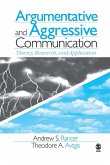Andrew S. Rancer, Theodore A. Avtgis
Argumentative and Aggressive Communication
Theory, Research, and Application
Andrew S. Rancer, Theodore A. Avtgis
Argumentative and Aggressive Communication
Theory, Research, and Application
- Gebundenes Buch
- Merkliste
- Auf die Merkliste
- Bewerten Bewerten
- Teilen
- Produkt teilen
- Produkterinnerung
- Produkterinnerung
Argumentative and Aggressive Communication: Theory, Research, and Application is the first text to describe the development, history, research, and application efforts on the communication traits of argumentativeness and verbal aggressiveness. Authors Andrew S. Rancer and Theodore A. Avtgis include a collection of nine widely used reliable and valid instruments which the reader, the researcher, and the practitioner can use for diagnostic and research purposes.
Andere Kunden interessierten sich auch für
![Argumentative and Aggressive Communication Argumentative and Aggressive Communication]() Andrew S. RancerArgumentative and Aggressive Communication103,99 €
Andrew S. RancerArgumentative and Aggressive Communication103,99 €![The Rorschach Assessment of Aggressive and Psychopathic Personalities The Rorschach Assessment of Aggressive and Psychopathic Personalities]() Carl B. GaconoThe Rorschach Assessment of Aggressive and Psychopathic Personalities74,99 €
Carl B. GaconoThe Rorschach Assessment of Aggressive and Psychopathic Personalities74,99 €![OFFICIAL WORKBOOK for Read People Like a Book OFFICIAL WORKBOOK for Read People Like a Book]() Patrick KingOFFICIAL WORKBOOK for Read People Like a Book23,99 €
Patrick KingOFFICIAL WORKBOOK for Read People Like a Book23,99 €![OFFICIAL WORKBOOK for Read People Like a Book OFFICIAL WORKBOOK for Read People Like a Book]() Patrick KingOFFICIAL WORKBOOK for Read People Like a Book19,99 €
Patrick KingOFFICIAL WORKBOOK for Read People Like a Book19,99 €![Current Topics in the Theory and Application of Latent Variable Models Current Topics in the Theory and Application of Latent Variable Models]() Current Topics in the Theory and Application of Latent Variable Models78,99 €
Current Topics in the Theory and Application of Latent Variable Models78,99 €![The Routledge Dictionary of Nonverbal Communication The Routledge Dictionary of Nonverbal Communication]() David B. GivensThe Routledge Dictionary of Nonverbal Communication201,99 €
David B. GivensThe Routledge Dictionary of Nonverbal Communication201,99 €![The Science and Application of Positive Psychology The Science and Application of Positive Psychology]() Jennifer S. CheavensThe Science and Application of Positive Psychology196,99 €
Jennifer S. CheavensThe Science and Application of Positive Psychology196,99 €-
-
-
Argumentative and Aggressive Communication: Theory, Research, and Application is the first text to describe the development, history, research, and application efforts on the communication traits of argumentativeness and verbal aggressiveness. Authors Andrew S. Rancer and Theodore A. Avtgis include a collection of nine widely used reliable and valid instruments which the reader, the researcher, and the practitioner can use for diagnostic and research purposes.
Hinweis: Dieser Artikel kann nur an eine deutsche Lieferadresse ausgeliefert werden.
Hinweis: Dieser Artikel kann nur an eine deutsche Lieferadresse ausgeliefert werden.
Produktdetails
- Produktdetails
- Verlag: Sage Publications, Inc
- Seitenzahl: 336
- Erscheinungstermin: 5. April 2006
- Englisch
- Abmessung: 235mm x 157mm x 23mm
- Gewicht: 638g
- ISBN-13: 9780761930884
- ISBN-10: 0761930884
- Artikelnr.: 22440892
- Herstellerkennzeichnung
- Books on Demand GmbH
- In de Tarpen 42
- 22848 Norderstedt
- info@bod.de
- 040 53433511
- Verlag: Sage Publications, Inc
- Seitenzahl: 336
- Erscheinungstermin: 5. April 2006
- Englisch
- Abmessung: 235mm x 157mm x 23mm
- Gewicht: 638g
- ISBN-13: 9780761930884
- ISBN-10: 0761930884
- Artikelnr.: 22440892
- Herstellerkennzeichnung
- Books on Demand GmbH
- In de Tarpen 42
- 22848 Norderstedt
- info@bod.de
- 040 53433511
Andrew S. Rancer (Ph.D., Kent State University) is professor of communication at The University of Akron in Akron, Ohio. He teaches communication theory, communication research, nonverbal communication, training methods in communication, and personality and communication to both undergraduate and M.A. students. Andrew¿s research focuses on the role of argumentative and verbally aggressive communication and other personality traits across a wide variety of contexts. He has published in Communication Monographs, Human Communication Research, Communication Education, Communication Quarterly, the Journal of Intercultural Communication Research, and the Journal of Personality Assessment, among other places. He has also published several book chapters, and is one of the coauthors of the widely used textbook, Building Communication Theory.
Part I: The Structure and Origin of Argumentative and Aggressive
Communication
1. What are Argumentative and Aggressive Communication?
The Genesis of the Theory of Argumentative and Aggressive Communication
Purpose of This Book
The Importance of Communication Traits
What are Communication Traits?
What is Aggressive Communication?
Constructive Aggressive Communication Traits
Categories of Trait Argumentativeness
Destructive Aggressive Communication Traits
Causes of Verbal Aggressiveness
Argumentative and Aggressive Communication Traits and Personality Theory
The Dimensions of Personality
The Relationship Between Temperament and Aggressive Communication Traits
Conclusion
Discussion Questions for Chapter 1
2. Measuring Individual Differences in Argumentative and Agressive
Communication
Measuring the Argumentative and Verbal Aggressiveness Traits
The Development of the Argumentative Scale
The Development of the Verbal Aggressivness Scale
Challenges to the Scales
Critiques of the Argumentativeness Scale
Critiques of the Verbal Aggressiveness Scale
Alternative Methods of Assessing Argumentative and Aggressive Communication
Assessing Beliefs About Argumentative and Aggressive Communication
Conclusion
Discussion Questions for Chapter 2
3. Trait, State, and Interactionist Approaches to Studying Argumentative
and Aggressive Communication
The Trait Perspective on Argumentative and Aggressive Communication
The Situationist Perspective on Argumentative and Aggressive Communication
Situational Factors: Topic and Topic Salience
Situational Factors: The Adversary¿s Attributes
Argument Topic
Context and Characteristics as Situational Influences
The Interactionist Approach to Argumentative and Aggressive Communication
Conclusion
Discussion Questions for Chapter 3
Part II: The Function of Argumentative and Aggressive Communication
4. Argumentative and Aggressive Communication in Relational and Family
Contexts
Argumentativeness and Verbal Aggressiveness in General Interpersonal
Relationships
Friendship Relationships
Dating Relationships
Family Relationships
Marital Relationships
Argumentativeness, Verbal Aggressiveness, and Interspousal Violence
Sibling Pairs
Parent-Child Dyads
Conclusion
Discussion Questions for Chapter 4
5. Argumentative and Aggressive Communication in Organizational Contexts
Organizational Satisfaction
Argumentativeness, Verbal Aggressiveness and Satisfaction
Argumentativeness, Verbal Aggressiveness and Gender Differences in the
Organization
Argumentativeness, Verbal Aggressiveness and Other Organizational
Constructs
Conclusion
Discussion Questions for Chapter 5
6. Argumentative and Verbally Aggressive Communication in Instructional
Contexts
The Influence of Instructor Trait Argumentativeness
The Influence of Instructor Trait Verbal Aggressiveness
The Influence of Instructor Use of Verbally Aggressive Messages
Characteristics of the Argumentative Student
Conclusion
Discussion Questions for Chapter 6
7. Argumentative and Aggressive Communication in Intercultural and
Intracultural Contexts
Co-Cultural Differences in Argumentative and Verbal Aggressiveness
Regional Differences in Argumentativeness and Verbal Aggressiveness
West Meets West
East Meets West
Conclusion
Discussion Questions for Chapter 7
8. Argumentative and Aggressive Communication in Mass and Mediated
Communication
Social Learning, the Media and Aggression
Television Situation Comedies
Comparing Sitcoms to Other Television Genres
Televised Wrestling
Music
Other Mediated Communication Research
Conclusion
Discussion Questions for Chapter 8
9. Argumentative and Aggressive Communication in Persuasion and Social
Influence Situations
An Orientation to Persuasion
An Orientation to Compliance-Gaining
Persuasion and Compliance-Gaining Research: A focus on Traits
A Transactional Approach to Argumentativeness and Persuasion
Processing Persuasive Messages: The Influence of Argumentative and
Aggressive Communication
Argumentativeness, Verbal Aggressiveness and Compliance-Gaining Behavior
Determining Intentions to Argue: Testing Two Frameworks
Argumentative and Aggressive Communication and Resistance to Persuasion
Conclusion
Discussion Questions for Chapter 9
Part III: Enhancing Communicative Outcomes Through Improved Understanding
of Argumentative and Aggressive Communication Processes
10. Modifying Argumentative and Aggressive Communication
The Call for Training
The Inventional System
Training Adults to Argue Constructively
Training in Argument
Training Adolescents to Argue Constructively
Conclusion
Discussion Questions for Chapter 10
11. Relating Argumentative and Aggressive Communication with Apprehension,
Adaptation and Personality Traits
The Relationship of Argumentativeness, Verbal Aggressiveness and
Apprehension Traits
The Relationship of Argumentativeness, Verbal Aggressiveness and
Personality Traits
Conclusion
Discussion Questions for Chapter 11
12. Advancing Research and Theory-Building Efforts on Argumentative and
Aggressive Communication
A Problem-Centered Approach to Communication Inquiry
The Research Contributions
A Focus on the Message/Individual
Cultural Influence Focus
Theoretical Foundation/Meta-Theory Focus
Measurement/Theoretical Refinement Focus
Conclusion
Discussion Questions for Chapter 12
Appendix A - The Argumentativeness and Verbal Aggressiveness Scales
Appendix B - The Adolescent Argumentativeness and Verbal Aggressiveness
Scales
Appendix C - Short-Form Versions of the Argumentativeness and Verbal
Aggressiveness Scales
Appendix D - The Affective-Behavioral-Cognitive Scale (ABCAS)
Appendix E - The Indirect Interpersonal Aggressiveness Scale
Appendix F - The Beliefs About Arguing Measure
Appendix G - Additional Resources on Argumentative and Aggressive
Communication
References
Index
Communication
1. What are Argumentative and Aggressive Communication?
The Genesis of the Theory of Argumentative and Aggressive Communication
Purpose of This Book
The Importance of Communication Traits
What are Communication Traits?
What is Aggressive Communication?
Constructive Aggressive Communication Traits
Categories of Trait Argumentativeness
Destructive Aggressive Communication Traits
Causes of Verbal Aggressiveness
Argumentative and Aggressive Communication Traits and Personality Theory
The Dimensions of Personality
The Relationship Between Temperament and Aggressive Communication Traits
Conclusion
Discussion Questions for Chapter 1
2. Measuring Individual Differences in Argumentative and Agressive
Communication
Measuring the Argumentative and Verbal Aggressiveness Traits
The Development of the Argumentative Scale
The Development of the Verbal Aggressivness Scale
Challenges to the Scales
Critiques of the Argumentativeness Scale
Critiques of the Verbal Aggressiveness Scale
Alternative Methods of Assessing Argumentative and Aggressive Communication
Assessing Beliefs About Argumentative and Aggressive Communication
Conclusion
Discussion Questions for Chapter 2
3. Trait, State, and Interactionist Approaches to Studying Argumentative
and Aggressive Communication
The Trait Perspective on Argumentative and Aggressive Communication
The Situationist Perspective on Argumentative and Aggressive Communication
Situational Factors: Topic and Topic Salience
Situational Factors: The Adversary¿s Attributes
Argument Topic
Context and Characteristics as Situational Influences
The Interactionist Approach to Argumentative and Aggressive Communication
Conclusion
Discussion Questions for Chapter 3
Part II: The Function of Argumentative and Aggressive Communication
4. Argumentative and Aggressive Communication in Relational and Family
Contexts
Argumentativeness and Verbal Aggressiveness in General Interpersonal
Relationships
Friendship Relationships
Dating Relationships
Family Relationships
Marital Relationships
Argumentativeness, Verbal Aggressiveness, and Interspousal Violence
Sibling Pairs
Parent-Child Dyads
Conclusion
Discussion Questions for Chapter 4
5. Argumentative and Aggressive Communication in Organizational Contexts
Organizational Satisfaction
Argumentativeness, Verbal Aggressiveness and Satisfaction
Argumentativeness, Verbal Aggressiveness and Gender Differences in the
Organization
Argumentativeness, Verbal Aggressiveness and Other Organizational
Constructs
Conclusion
Discussion Questions for Chapter 5
6. Argumentative and Verbally Aggressive Communication in Instructional
Contexts
The Influence of Instructor Trait Argumentativeness
The Influence of Instructor Trait Verbal Aggressiveness
The Influence of Instructor Use of Verbally Aggressive Messages
Characteristics of the Argumentative Student
Conclusion
Discussion Questions for Chapter 6
7. Argumentative and Aggressive Communication in Intercultural and
Intracultural Contexts
Co-Cultural Differences in Argumentative and Verbal Aggressiveness
Regional Differences in Argumentativeness and Verbal Aggressiveness
West Meets West
East Meets West
Conclusion
Discussion Questions for Chapter 7
8. Argumentative and Aggressive Communication in Mass and Mediated
Communication
Social Learning, the Media and Aggression
Television Situation Comedies
Comparing Sitcoms to Other Television Genres
Televised Wrestling
Music
Other Mediated Communication Research
Conclusion
Discussion Questions for Chapter 8
9. Argumentative and Aggressive Communication in Persuasion and Social
Influence Situations
An Orientation to Persuasion
An Orientation to Compliance-Gaining
Persuasion and Compliance-Gaining Research: A focus on Traits
A Transactional Approach to Argumentativeness and Persuasion
Processing Persuasive Messages: The Influence of Argumentative and
Aggressive Communication
Argumentativeness, Verbal Aggressiveness and Compliance-Gaining Behavior
Determining Intentions to Argue: Testing Two Frameworks
Argumentative and Aggressive Communication and Resistance to Persuasion
Conclusion
Discussion Questions for Chapter 9
Part III: Enhancing Communicative Outcomes Through Improved Understanding
of Argumentative and Aggressive Communication Processes
10. Modifying Argumentative and Aggressive Communication
The Call for Training
The Inventional System
Training Adults to Argue Constructively
Training in Argument
Training Adolescents to Argue Constructively
Conclusion
Discussion Questions for Chapter 10
11. Relating Argumentative and Aggressive Communication with Apprehension,
Adaptation and Personality Traits
The Relationship of Argumentativeness, Verbal Aggressiveness and
Apprehension Traits
The Relationship of Argumentativeness, Verbal Aggressiveness and
Personality Traits
Conclusion
Discussion Questions for Chapter 11
12. Advancing Research and Theory-Building Efforts on Argumentative and
Aggressive Communication
A Problem-Centered Approach to Communication Inquiry
The Research Contributions
A Focus on the Message/Individual
Cultural Influence Focus
Theoretical Foundation/Meta-Theory Focus
Measurement/Theoretical Refinement Focus
Conclusion
Discussion Questions for Chapter 12
Appendix A - The Argumentativeness and Verbal Aggressiveness Scales
Appendix B - The Adolescent Argumentativeness and Verbal Aggressiveness
Scales
Appendix C - Short-Form Versions of the Argumentativeness and Verbal
Aggressiveness Scales
Appendix D - The Affective-Behavioral-Cognitive Scale (ABCAS)
Appendix E - The Indirect Interpersonal Aggressiveness Scale
Appendix F - The Beliefs About Arguing Measure
Appendix G - Additional Resources on Argumentative and Aggressive
Communication
References
Index
Contents The Development of Aggressive Communication - Measurement and Assessment of Aggressive Communication - Theoretical Explanations of Aggressive Communication - Relational Implications of Aggressive Communication - Aggressive Communication in the Organization - Classroom Interaction and Aggressive Communication - Cultural Influences on Aggressive Communication - Aggressive Communication in Mediated Environments - Aggressive Communication in Persuasion - Training and Educating in Aggressive Communication - Aggressive Communication and Its Relationship to Personality - Aggressive Communication: Tributaries and the Future.
Part I: The Structure and Origin of Argumentative and Aggressive
Communication
1. What are Argumentative and Aggressive Communication?
The Genesis of the Theory of Argumentative and Aggressive Communication
Purpose of This Book
The Importance of Communication Traits
What are Communication Traits?
What is Aggressive Communication?
Constructive Aggressive Communication Traits
Categories of Trait Argumentativeness
Destructive Aggressive Communication Traits
Causes of Verbal Aggressiveness
Argumentative and Aggressive Communication Traits and Personality Theory
The Dimensions of Personality
The Relationship Between Temperament and Aggressive Communication Traits
Conclusion
Discussion Questions for Chapter 1
2. Measuring Individual Differences in Argumentative and Agressive
Communication
Measuring the Argumentative and Verbal Aggressiveness Traits
The Development of the Argumentative Scale
The Development of the Verbal Aggressivness Scale
Challenges to the Scales
Critiques of the Argumentativeness Scale
Critiques of the Verbal Aggressiveness Scale
Alternative Methods of Assessing Argumentative and Aggressive Communication
Assessing Beliefs About Argumentative and Aggressive Communication
Conclusion
Discussion Questions for Chapter 2
3. Trait, State, and Interactionist Approaches to Studying Argumentative
and Aggressive Communication
The Trait Perspective on Argumentative and Aggressive Communication
The Situationist Perspective on Argumentative and Aggressive Communication
Situational Factors: Topic and Topic Salience
Situational Factors: The Adversary¿s Attributes
Argument Topic
Context and Characteristics as Situational Influences
The Interactionist Approach to Argumentative and Aggressive Communication
Conclusion
Discussion Questions for Chapter 3
Part II: The Function of Argumentative and Aggressive Communication
4. Argumentative and Aggressive Communication in Relational and Family
Contexts
Argumentativeness and Verbal Aggressiveness in General Interpersonal
Relationships
Friendship Relationships
Dating Relationships
Family Relationships
Marital Relationships
Argumentativeness, Verbal Aggressiveness, and Interspousal Violence
Sibling Pairs
Parent-Child Dyads
Conclusion
Discussion Questions for Chapter 4
5. Argumentative and Aggressive Communication in Organizational Contexts
Organizational Satisfaction
Argumentativeness, Verbal Aggressiveness and Satisfaction
Argumentativeness, Verbal Aggressiveness and Gender Differences in the
Organization
Argumentativeness, Verbal Aggressiveness and Other Organizational
Constructs
Conclusion
Discussion Questions for Chapter 5
6. Argumentative and Verbally Aggressive Communication in Instructional
Contexts
The Influence of Instructor Trait Argumentativeness
The Influence of Instructor Trait Verbal Aggressiveness
The Influence of Instructor Use of Verbally Aggressive Messages
Characteristics of the Argumentative Student
Conclusion
Discussion Questions for Chapter 6
7. Argumentative and Aggressive Communication in Intercultural and
Intracultural Contexts
Co-Cultural Differences in Argumentative and Verbal Aggressiveness
Regional Differences in Argumentativeness and Verbal Aggressiveness
West Meets West
East Meets West
Conclusion
Discussion Questions for Chapter 7
8. Argumentative and Aggressive Communication in Mass and Mediated
Communication
Social Learning, the Media and Aggression
Television Situation Comedies
Comparing Sitcoms to Other Television Genres
Televised Wrestling
Music
Other Mediated Communication Research
Conclusion
Discussion Questions for Chapter 8
9. Argumentative and Aggressive Communication in Persuasion and Social
Influence Situations
An Orientation to Persuasion
An Orientation to Compliance-Gaining
Persuasion and Compliance-Gaining Research: A focus on Traits
A Transactional Approach to Argumentativeness and Persuasion
Processing Persuasive Messages: The Influence of Argumentative and
Aggressive Communication
Argumentativeness, Verbal Aggressiveness and Compliance-Gaining Behavior
Determining Intentions to Argue: Testing Two Frameworks
Argumentative and Aggressive Communication and Resistance to Persuasion
Conclusion
Discussion Questions for Chapter 9
Part III: Enhancing Communicative Outcomes Through Improved Understanding
of Argumentative and Aggressive Communication Processes
10. Modifying Argumentative and Aggressive Communication
The Call for Training
The Inventional System
Training Adults to Argue Constructively
Training in Argument
Training Adolescents to Argue Constructively
Conclusion
Discussion Questions for Chapter 10
11. Relating Argumentative and Aggressive Communication with Apprehension,
Adaptation and Personality Traits
The Relationship of Argumentativeness, Verbal Aggressiveness and
Apprehension Traits
The Relationship of Argumentativeness, Verbal Aggressiveness and
Personality Traits
Conclusion
Discussion Questions for Chapter 11
12. Advancing Research and Theory-Building Efforts on Argumentative and
Aggressive Communication
A Problem-Centered Approach to Communication Inquiry
The Research Contributions
A Focus on the Message/Individual
Cultural Influence Focus
Theoretical Foundation/Meta-Theory Focus
Measurement/Theoretical Refinement Focus
Conclusion
Discussion Questions for Chapter 12
Appendix A - The Argumentativeness and Verbal Aggressiveness Scales
Appendix B - The Adolescent Argumentativeness and Verbal Aggressiveness
Scales
Appendix C - Short-Form Versions of the Argumentativeness and Verbal
Aggressiveness Scales
Appendix D - The Affective-Behavioral-Cognitive Scale (ABCAS)
Appendix E - The Indirect Interpersonal Aggressiveness Scale
Appendix F - The Beliefs About Arguing Measure
Appendix G - Additional Resources on Argumentative and Aggressive
Communication
References
Index
Communication
1. What are Argumentative and Aggressive Communication?
The Genesis of the Theory of Argumentative and Aggressive Communication
Purpose of This Book
The Importance of Communication Traits
What are Communication Traits?
What is Aggressive Communication?
Constructive Aggressive Communication Traits
Categories of Trait Argumentativeness
Destructive Aggressive Communication Traits
Causes of Verbal Aggressiveness
Argumentative and Aggressive Communication Traits and Personality Theory
The Dimensions of Personality
The Relationship Between Temperament and Aggressive Communication Traits
Conclusion
Discussion Questions for Chapter 1
2. Measuring Individual Differences in Argumentative and Agressive
Communication
Measuring the Argumentative and Verbal Aggressiveness Traits
The Development of the Argumentative Scale
The Development of the Verbal Aggressivness Scale
Challenges to the Scales
Critiques of the Argumentativeness Scale
Critiques of the Verbal Aggressiveness Scale
Alternative Methods of Assessing Argumentative and Aggressive Communication
Assessing Beliefs About Argumentative and Aggressive Communication
Conclusion
Discussion Questions for Chapter 2
3. Trait, State, and Interactionist Approaches to Studying Argumentative
and Aggressive Communication
The Trait Perspective on Argumentative and Aggressive Communication
The Situationist Perspective on Argumentative and Aggressive Communication
Situational Factors: Topic and Topic Salience
Situational Factors: The Adversary¿s Attributes
Argument Topic
Context and Characteristics as Situational Influences
The Interactionist Approach to Argumentative and Aggressive Communication
Conclusion
Discussion Questions for Chapter 3
Part II: The Function of Argumentative and Aggressive Communication
4. Argumentative and Aggressive Communication in Relational and Family
Contexts
Argumentativeness and Verbal Aggressiveness in General Interpersonal
Relationships
Friendship Relationships
Dating Relationships
Family Relationships
Marital Relationships
Argumentativeness, Verbal Aggressiveness, and Interspousal Violence
Sibling Pairs
Parent-Child Dyads
Conclusion
Discussion Questions for Chapter 4
5. Argumentative and Aggressive Communication in Organizational Contexts
Organizational Satisfaction
Argumentativeness, Verbal Aggressiveness and Satisfaction
Argumentativeness, Verbal Aggressiveness and Gender Differences in the
Organization
Argumentativeness, Verbal Aggressiveness and Other Organizational
Constructs
Conclusion
Discussion Questions for Chapter 5
6. Argumentative and Verbally Aggressive Communication in Instructional
Contexts
The Influence of Instructor Trait Argumentativeness
The Influence of Instructor Trait Verbal Aggressiveness
The Influence of Instructor Use of Verbally Aggressive Messages
Characteristics of the Argumentative Student
Conclusion
Discussion Questions for Chapter 6
7. Argumentative and Aggressive Communication in Intercultural and
Intracultural Contexts
Co-Cultural Differences in Argumentative and Verbal Aggressiveness
Regional Differences in Argumentativeness and Verbal Aggressiveness
West Meets West
East Meets West
Conclusion
Discussion Questions for Chapter 7
8. Argumentative and Aggressive Communication in Mass and Mediated
Communication
Social Learning, the Media and Aggression
Television Situation Comedies
Comparing Sitcoms to Other Television Genres
Televised Wrestling
Music
Other Mediated Communication Research
Conclusion
Discussion Questions for Chapter 8
9. Argumentative and Aggressive Communication in Persuasion and Social
Influence Situations
An Orientation to Persuasion
An Orientation to Compliance-Gaining
Persuasion and Compliance-Gaining Research: A focus on Traits
A Transactional Approach to Argumentativeness and Persuasion
Processing Persuasive Messages: The Influence of Argumentative and
Aggressive Communication
Argumentativeness, Verbal Aggressiveness and Compliance-Gaining Behavior
Determining Intentions to Argue: Testing Two Frameworks
Argumentative and Aggressive Communication and Resistance to Persuasion
Conclusion
Discussion Questions for Chapter 9
Part III: Enhancing Communicative Outcomes Through Improved Understanding
of Argumentative and Aggressive Communication Processes
10. Modifying Argumentative and Aggressive Communication
The Call for Training
The Inventional System
Training Adults to Argue Constructively
Training in Argument
Training Adolescents to Argue Constructively
Conclusion
Discussion Questions for Chapter 10
11. Relating Argumentative and Aggressive Communication with Apprehension,
Adaptation and Personality Traits
The Relationship of Argumentativeness, Verbal Aggressiveness and
Apprehension Traits
The Relationship of Argumentativeness, Verbal Aggressiveness and
Personality Traits
Conclusion
Discussion Questions for Chapter 11
12. Advancing Research and Theory-Building Efforts on Argumentative and
Aggressive Communication
A Problem-Centered Approach to Communication Inquiry
The Research Contributions
A Focus on the Message/Individual
Cultural Influence Focus
Theoretical Foundation/Meta-Theory Focus
Measurement/Theoretical Refinement Focus
Conclusion
Discussion Questions for Chapter 12
Appendix A - The Argumentativeness and Verbal Aggressiveness Scales
Appendix B - The Adolescent Argumentativeness and Verbal Aggressiveness
Scales
Appendix C - Short-Form Versions of the Argumentativeness and Verbal
Aggressiveness Scales
Appendix D - The Affective-Behavioral-Cognitive Scale (ABCAS)
Appendix E - The Indirect Interpersonal Aggressiveness Scale
Appendix F - The Beliefs About Arguing Measure
Appendix G - Additional Resources on Argumentative and Aggressive
Communication
References
Index
Contents The Development of Aggressive Communication - Measurement and Assessment of Aggressive Communication - Theoretical Explanations of Aggressive Communication - Relational Implications of Aggressive Communication - Aggressive Communication in the Organization - Classroom Interaction and Aggressive Communication - Cultural Influences on Aggressive Communication - Aggressive Communication in Mediated Environments - Aggressive Communication in Persuasion - Training and Educating in Aggressive Communication - Aggressive Communication and Its Relationship to Personality - Aggressive Communication: Tributaries and the Future.
«Written for undergraduates and researchers alike, this concise and impressive book contains adult, adolescent, long, and short versions of the Argumentativeness and Verbal Aggressiveness scales, and twelve well-written and thoroughly researched chapters. If studying these traits ever becomes a religion, this book will be its bible!» (Charles J. Wigley III, Canisius College)
«Rancer and Avtgis provide a comprehensive examination of argumentativeness and verbal aggressiveness. The breadth of contextual explorations and the depth with which they capture the nature and application of these constructs are impressive, making this book an essential resource handbook for students and scholars alike.» (Rachel DiCioccio, University of Rhode Island)
«Rancer and Avtgis provide a comprehensive examination of argumentativeness and verbal aggressiveness. The breadth of contextual explorations and the depth with which they capture the nature and application of these constructs are impressive, making this book an essential resource handbook for students and scholars alike.» (Rachel DiCioccio, University of Rhode Island)








